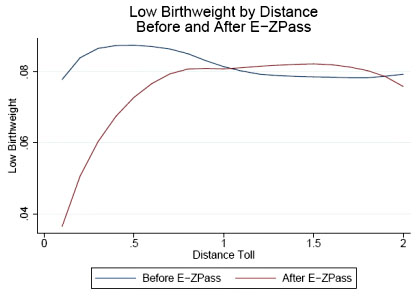How dangerous is it to live near areas of heavy traffic congestion? Janet Currie and Reed Walker of Columbia University have done a clever study to try to get a handle on this. They took a look at the incidence of low birthweight in babies born to mothers who lived near busy  toll plazas before and after E-ZPass was introduced. Their idea was that E-ZPass reduced congestion, and therefore mothers living near toll plazas ought to benefit from it. And they did:
toll plazas before and after E-ZPass was introduced. Their idea was that E-ZPass reduced congestion, and therefore mothers living near toll plazas ought to benefit from it. And they did:
We find that reductions in traffic congestion generated by E-ZPass reduced the incidence of prematurity and low birth weight among mothers within 2km of a toll plaza by 6.7-9.1% and 8.5-11.3% respectively, with larger effects for African-Americans, smokers, and those very close to toll plazas….The results suggest that traffic congestion is a significant contributor to poor
health in affected infants.
As you can see from the chart, E-ZPass reduced the incidence of low birthweights by half for mothers who lived within a couple hundred yards of a toll plaza. The effect decreased with distance, and at about a kilometer out the effect went away, presumably washed out by the ordinary background traffic congestion in the area. Results are similar for premature births. The public policy conclusions are a little unclear here, aside from the fact that E-ZPass is good and breathing auto fumes is bad, but it’s useful to put a number to this stuff.
(Via Austin Frakt, by email.)

















